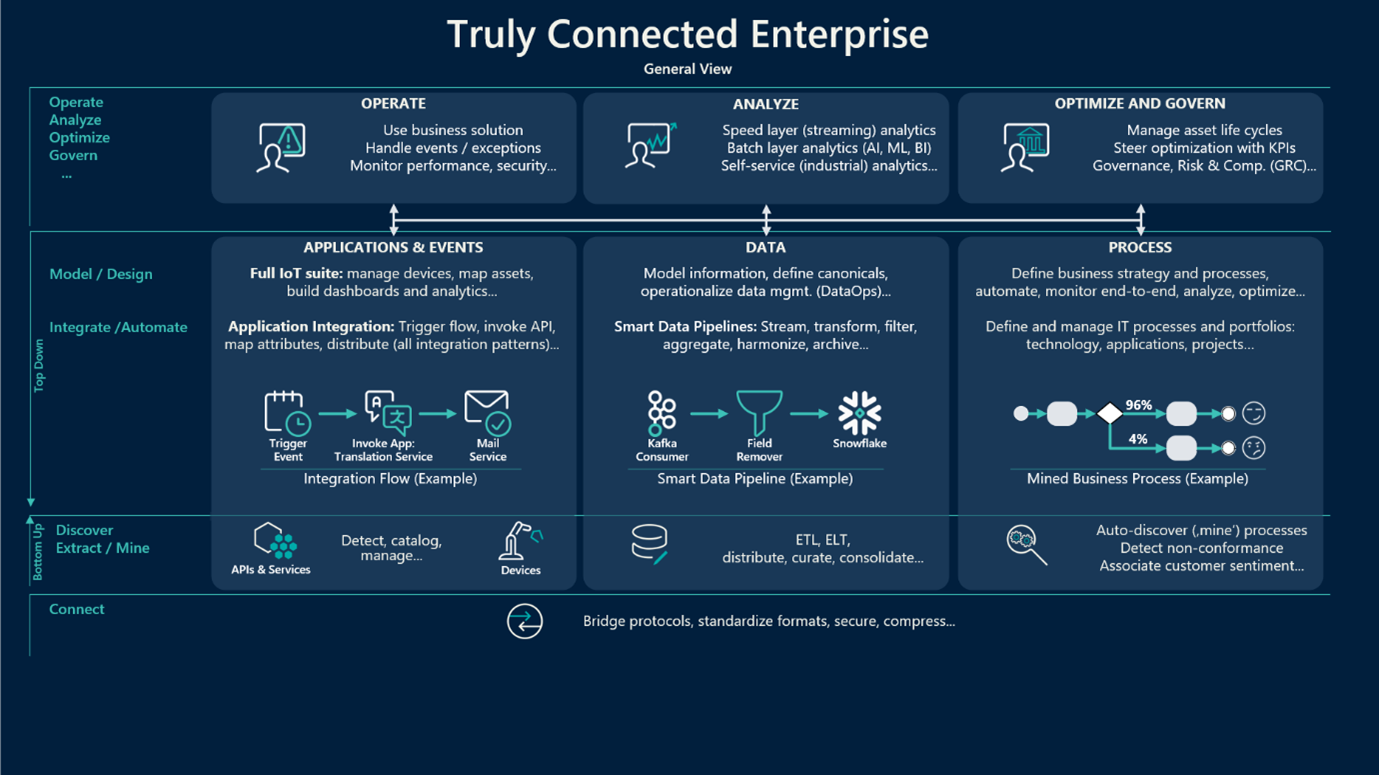Reference architectures: Structure and simplicity in the connected world
What does it take to become a truly connected enterprise, can it be broken down and made more tangible for me, and in concrete terms, what do Software AG products enable me to do?

We often hear questions like these. A short answer is difficult to give, because true connectivity deals with a variety of integration objects: functional integration of applications; curated and consolidating integration of data; composition and mining of business processes; insight-generating integration of IoT ‘things’ and the events they emit; and more.
The world of integration has many dimensions, and therefore Software AG’s solution portfolio is comprehensive. Fortunately, the Software AG Reference Architectures provide a visual, intuitive access to this world.

The new highest-level ‘General View’ gives an outline of the entire truly connected enterprise. It uses separate areas to distinguish between integration for applications & events, data and processes.
It also provides four horizontal layers. The core idea is to separate capabilities that support a ‘bottom-up’ versus a ‘top-down’ approach. The ‘bottom-up’ approach extracts existing objects and correlates them in new, insight-generating ways. Prominent examples are process mining and data warehousing. ‘Top-down’, on the other hand, starts with modeling or designing and then continues toward implementation. The ‘API first’ approach is an example of a process hierarchy.
By nature, such a high-level view omits many details. But it is the perfect visual aid to find structure in the chaos, a place to sort your thoughts and start conversations from. The first of the three questions above is: what does it take to become a truly connected enterprise? The answer, in a nutshell: as shown in the General View, to weave and leverage a connectivity fabric across different integration objects, based on top-down and bottom-up capabilities.
The second question is: can you break it down, make it more tangible for me? Absolutely! The General View is only the starting point of the reference architectures. In particular, separate architectures are provided that detail the areas
- Application integration and API management, showing application integration and how it relates to data integration;
- IoT and analytics, showing IoT / event integration and how it relates to data integration; and
- Business transformation, showing process integration and how it relates to business strategy and portfolio management
These architectures follow the topography (areas and layers) of the General View. They show the next level of detail with regard to the capabilities required. Altogether they constitute a complete and rounded view of a truly connected enterprise.
What sets Software AG apart is that it provides capabilities, making all of this a reality, not stopping at the boundaries of one particular integration object. That would create integration silos, and if there is one discipline that should not create silos, it is integration.
The architectures are primarily about capabilities, not products or deployment, as capabilities are the first thing to identify. However, they also support the next step: They can be toggled to a ‘product view’ showing the Software AG products providing the capabilities, and giving basic information on product deployment options.
Talking about capabilities first and products afterward is certainly best. But in real life, people sometimes just stumble over a product name and want to learn more. Well, the architectures cut both ways: starting from a product name, toggling shows its main capabilities and the context it operates in.
So, the ‘product view’ feature responds to the third and final question: What, in concrete terms, do Software AG’s products enable me to do?
A final comment: As reference architectures, they provide overview, suggest a way to structure things and can also serve as a checklist (‘Did we consider this? Is our strategy complete?’). Most enterprises will identify some capabilities that are not applicable for them. If you find this visualization useful, Software AG is more than happy to create a tailored version of it for you that depicts your very individual version of a truly connected enterprise.